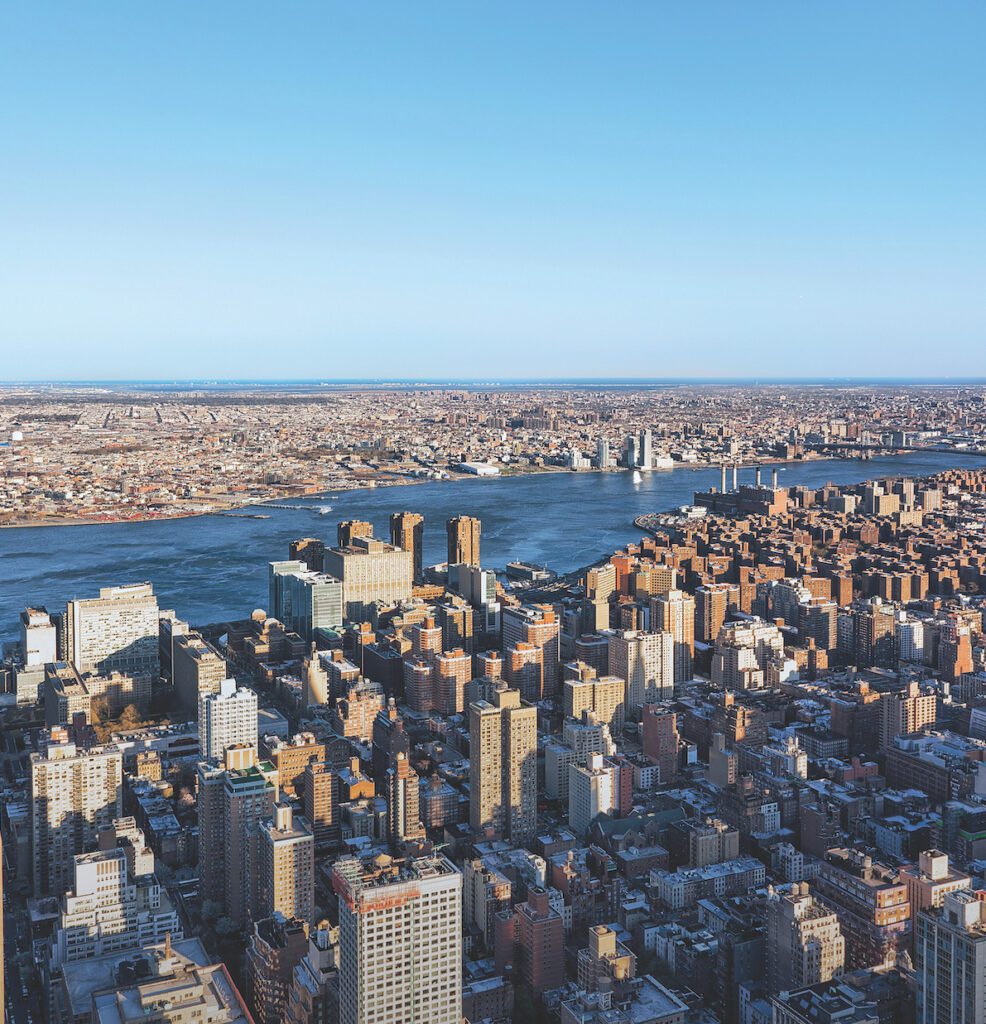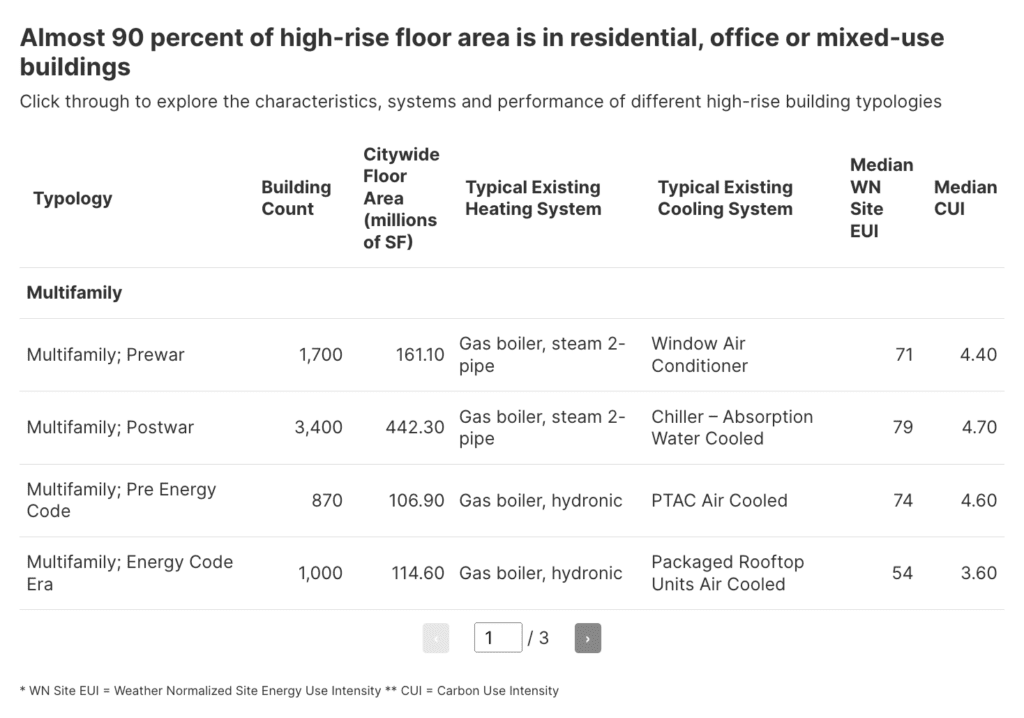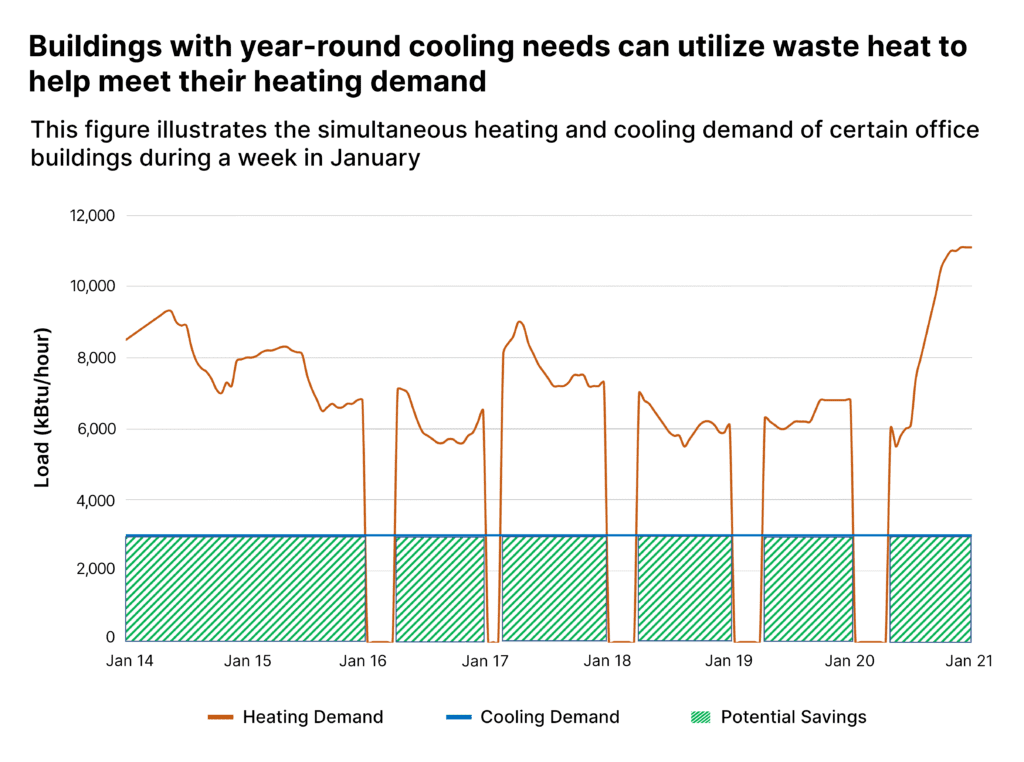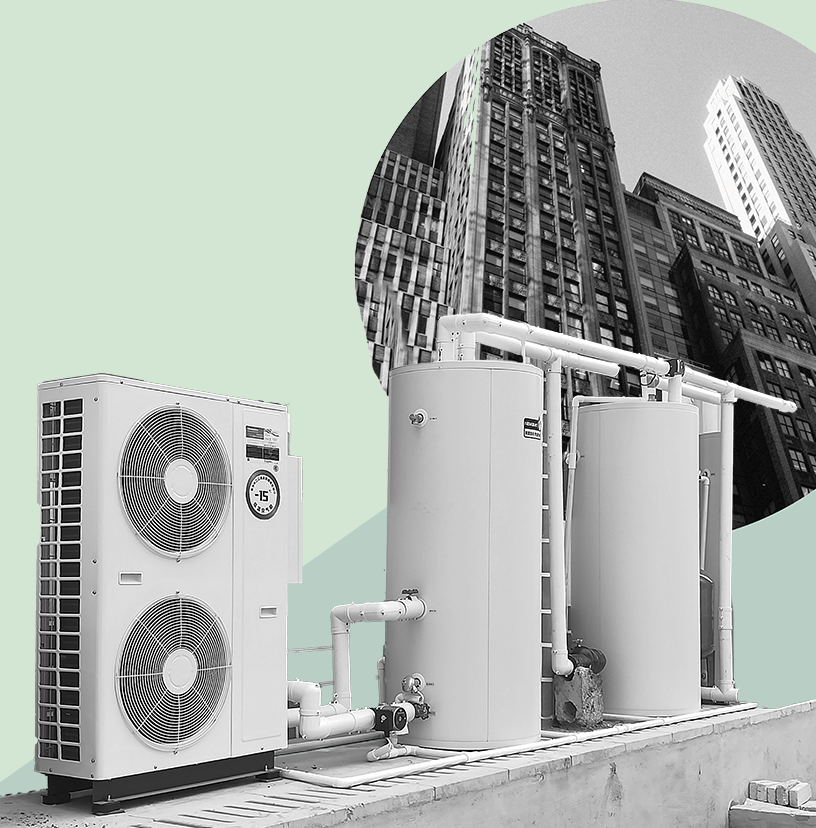Heat pumps could help thousands of NYC’s largest buildings reuse their wasted heat.
Original publication by Urban Green Council • May 1, 2024
High-rise buildings—iconic symbols of the New York City skyline—are ripe for smart, strategic retrofits to accelerate statewide decarbonization. Capturing the substantial wasted heat from residential towers and office buildings is a great place to start. With heat recovery retrofits, building owners and managers can leverage and reuse energy that has already been paid for, which is an attractive way to reduce total energy use on the path toward deeper decarbonization retrofits.
In this analysis, we introduce the concept of heat recovery for high-rise buildings, explore its applicability across different building types with chilled water cooling systems, and use NYC’s trove of audit and other public data to illuminate this potential decarbonization market opportunity.

Highlights
- Many of NYC’s 12,000 high-rise buildings are candidates for heat recovery as an early step on the path to full decarbonization.
- Replacing conventional chillers with heat pumps enables buildings to share heat between different building systems and zones.
- 5,000+ buildings, many in Environmental Justice Areas, have cooling towers with wasted heat that could be recovered with a heat pump, displacing fossil fuel use, improving local air quality and reducing carbon intensity to comply with LL97.
Introducing the NYC high-rise
High-rise buildings more than seven stories tall contain about one-third of New York City’s building area—an enormous footprint that is crucial to statewide climate progress. The good news is total emissions from NYC’s largest buildings have fallen 27 percent since 2010. But we have a long way to go to net-zero. A data-based dive into this sector can help illuminate scalable retrofit market opportunities.
New York City’s benchmarking and audit data offer a uniquely detailed look under the hood of the city’s large buildings. Below, Tables 1 and 2 segment NYC’s 12,000 plus high-rise buildings into 22 different typologies, with basic characteristics for each. Combining variables like Citywide Area and Carbon Use Intensity (CUI) allows us to define the potential for decarbonization within each typology, and to identify priority sectors accordingly. Variables such as the most likely heating and cooling systems can guide which retrofit solutions are applicable and potentially scalable across a given typology.
Table 1

Multifamily residential buildings are the most prevalent high-rise, with almost 9,000 properties entirely or partially residential. These properties total more than 1.1 billion square feet, about 20 percent of NYC’s total building square footage. Office buildings are the second most prevalent high-rise, covering almost 450 million square feet across more than 1,500 buildings—about eight percent of NYC’s total building area.
Over time, typical heating and cooling systems have shifted from steam toward hydronic distribution and central cooling. For example, residential buildings built before 1940 (pre-war) are most likely to have steam heat systems and rely on window air conditioners for cooling. Newer residential buildings tend to use hydronic distribution (water is piped throughout the building instead of steam) for heat and have central cooling systems, like absorption or electric chillers. Residential buildings built after 2011 (Energy Code Era) have much lower energy and carbon use intensities, driven by these more sophisticated heating and cooling systems and stricter energy code requirements. However, this same trend is not as visible in office buildings.
Table 2

The remaining 1,700 high-rise buildings in NYC serve a wide variety of use-types, from emergency rooms to classrooms. Aside from healthcare facilities, hotels are the largest and most carbon-intensive typology among these less prevalent high-rises, and they typically have hydronic heating and central cooling from electric chillers.
While every building is unique, typologies or groups of buildings with similar characteristics represent substantial market opportunities to scale innovative solutions—and market leaders can help mobilize those solutions. That’s the philosophy behind the New York State Energy Research and Development Authority (NYSERDA) Empire Building Challenge (EBC), a partnership with leading real estate owners to elevate new design approaches for low-carbon retrofits in New York’s high-rise buildings.
High-rise buildings need strategic, long-term plans to fully decarbonize. However, an impactful and accessible first step for many buildings is emerging in some EBC partner projects: installing equipment to capture and reuse energy that’s being wasted by current building systems.
Energy recovery from waste heat is smart, straightforward and impactful
Harvesting energy from waste streams—like sanitary drains, ventilation exhaust or condenser water loops—that would otherwise be lost to the environment is already common practice in new construction. And in certain circumstances, recovering heat is required by code. In existing buildings, these straightforward upgrades represent a sizable opportunity to save carbon, and they often don’t entail replacing a building’s current systems.
The three major categories of heat recovery that exist for NYC’s high-rise buildings:
- Wastewater Heat Recovery: Large amounts of heat energy are deposited down drains in buildings. In fact, 80 to 90 percent of a hot shower’s delivered thermal energy is lost down the drain immediately after use.[1]ACEEE – Harvey Sachs – Emerging Hot Water Tech and Practices for EE as of 2011 Extracting this heat before it goes to the sewer can significantly reduce the amount of energy a building uses for water heating.
- Airside Heat Recovery: Exhaust air contains heat that is typically lost to the atmosphere. Integrating heat recovery into a building’s ventilation system can capture and repurpose this heat to preheat fresh outside air brought into the building to maintain healthy indoor air quality.
- Waterside Heat Recovery: Central cooling systems often produce hot water as a byproduct. This water must be cooled before it can be cycled through the system again. Most buildings do this by exposing it to the outside air, wasting energy that could be captured and put to use supporting other building systems.
Most buildings have opportunities to implement one or more of these types of heat recovery; even well-managed buildings waste heat through wastewater, ventilation and cooling systems. In recognition of this opportunity, Governor Kathy Hochul announced a $12 million program to boost heat recovery solutions in retrofits of existing buildings across New York.
To help unpack the potential opportunity, we worked with NYSERDA’s EBC team to identify opportunities and educate the market on heat recovery upgrades in high-rise buildings with chilled water central cooling systems. Below, we put these opportunities in the context of the broader high-rise market and illustrate the upgrades with case studies of actual projects being implemented by market leaders.
Heat pumps can reuse wasted heat from cooling towers
In New York City, one of the biggest opportunities for energy recovery is in high-rise buildings with cooling towers. The central component responsible for cooling many high-rises is called a chiller, which removes heat from water to create a chilled water supply. That supply is then distributed through a building to cool its interior spaces. But the heat extracted to create this cooled water supply—now in the form of a separate hot water supply called a condenser water loop—must then be cooled down before it can return to the building system. That’s where cooling towers come into play: hot water is sent to cool in exposed towers on the building’s roof before returning to circulate through its chillers again. In this way, cooling towers act as sinks for excess heat from the operation of a building’s cooling system.
Energy recovery from cooling towers means capturing this heat energy before it is lost to the atmosphere, and using it to satisfy a building system need. Heat pumps—electrically powered systems that move heat from one place to another—can recycle this heat by extracting it from hot water in a condenser water loop before it reaches the cooling tower. Heat pumps transfer more thermal energy than they consume in electrical energy, which allows for energy savings by capturing waste heat.
In many multifamily buildings, this waste heat can then be used to preheat water that is needed for domestic hot water (DHW) demand, displacing a portion of the fossil fuels burned for DHW. Additionally, any building with a hydronic heating distribution system—including commercial buildings with multiple tenants with differing HVAC needs—can implement this process to preheat water for use in a space heating boiler.
Heat recovery projects can help meet our environmental justice and LL97 goals
A significant number of buildings in disadvantaged communities have cooling towers. Waterside heat recovery in these buildings represents an opportunity to help realize the state’s goal of driving 40 percent of the Climate Leadership and Community Protection Act’s benefits to disadvantaged communities. Figure 2 maps the 5,000+ buildings that have reported a cooling tower and identifies if the census tract they are in is designated by the City as an Environmental Justice Area.[2]The definitions in Local Law 64 of 2017 are as follows: A low income community is a census block where the low income population makes up greater than or equal to 23.59 percent of the total … Continue reading
Figure 1

There are also hundreds of high-rise buildings with cooling towers that need to reduce their emissions to meet 2030 LL97 limits (Figure 2). Energy recovery from cooling towers can be a strategic part of a package of retrofit measures to comply with LL97 on a long-term path to full decarbonization.
Figure 2

Table 3

Energy recovery from cooling towers also reduces the cost of maintaining a building’s cooling tower and saves money on its water bill. Eventually, most of these buildings will also need to fully electrify their DHW systems, and waste heat recovery will lower the demand—and cost—of their future heat pump water heater system. Eliminating the need for a cooling tower can also improve the health and safety of building operations by decreasing the risk of Legionnaires’ disease outbreaks.
Explore the case study below to learn more about a real NYC high-rise building using a heat pump to recover energy before it’s lost to their cooling tower:

Sharing heat is the future
Another heat recovery retrofit solution is to replace a building’s existing chiller(s) with heat pumps. There are two main types of chillers in NYC buildings: electric and absorption. These two technologies use different thermodynamic processes to move heat, and in general, electric chillers are more efficient. Electric chillers also have the benefit of not needing an on-site fossil fuel based heat source to operate. Therefore, replacing old absorption chillers removes a portion of fossil-fuel combustion from buildings and increases the energy efficiency of their cooling systems.
Heat pumps provide cooling in the same way as electric chillers, but they can also go into heating mode when needed. So, replacing some or all of a building’s chillers with heat pumps can lead to significant carbon reductions. Using NYC’s Local Law 87 energy audit data, we identified the cooling systems of over 3,000 of NYC’s 12,000 high-rise properties. Table 4 summarizes this data and highlights the opportunity to scale this solution to many buildings with electric or absorption chillers.
Table 4

A heat pump’s ability to both heat and cool unlocks the potential for heat recovery solutions in a broad range of building typologies. In many commercial and mixed-use buildings, there is often a need for simultaneous heating and cooling. This can be due to a building’s characteristics or occupancy types. For example, the glass facade on the south side of high-rise office buildings often needs substantial cooling in winter. The waste heat from this cooling can be used to heat other parts of the building that are less exposed to the sun.
Figure 3 shows the energy demand data for heating and cooling over a week in January for an NYC high-rise office building. The green shading illustrates the potential energy savings from using waste heat from cooling to offset a portion of the building’s heating demand.
Figure 3

Multiple space use-types in a building can also make installing heat pumps for heat recovery an attractive retrofit solution for building owners. For example, a mixed residential/commercial building could have a grocery store on the first floor with constant refrigeration (cooling) needs. Waste heat from this cooling could be used to preheat water for boilers serving residential units on the upper floors.
Each building owner will of course need to evaluate the specific systems, waste streams and opportunities of a given property. But a building with a combination of enabling characteristics makes waste heat recovery a particularly attractive retrofit option. Explore these characteristics by clicking on each circle in Figure 4:
Figure 4

Explore the case study below to learn more about how a real NYC high-rise building is leveraging its need for simultaneous heating and cooling to implement heat pumps for waste heat recovery:

Major potential for heat pumps to creatively unlock wasted energy and carbon savings
Many NYC high-rise buildings were designed and built before modern HVAC systems existed. Heat was wasted by design as a necessary byproduct of fully conditioning indoor spaces. But that is no longer the case.
Heat pump technology empowers designers to innovate strategic and creative solutions to capture waste heat and reuse it for other building energy needs. These heat recovery solutions will vary based on the particulars of a given building, but the underlying premise—using all the energy we’re already paying for—makes these interventions smart, straightforward and impactful.
Sharing heat doesn’t need to stop at the perimeter of a single building. As heat recovery moves to scale, clusters of buildings—like hospitals, universities and residential complexes—can use sewers, tunnels and pipes to share heat across campus thermal energy networks. From buildings to blocks to neighborhoods, heat recovery is a crucial part of the path to a net-zero future for New Yorkers.
Recovery through retrofits
New York State lost thousands of clean energy jobs in the spring of 2020, but the new clean economy offers hope.
Explore our NYC building data hub
Learn more about NYC's buildings and their energy use in this interactive data hub.
Local Law 97
NYC’s groundbreaking climate legislation sets carbon emissions caps for large buildings that began in 2024.
References
| ↑1 | ACEEE – Harvey Sachs – Emerging Hot Water Tech and Practices for EE as of 2011 |
|---|---|
| ↑2 | The definitions in Local Law 64 of 2017 are as follows: A low income community is a census block where the low income population makes up greater than or equal to 23.59 percent of the total population. A low income population is defined as a population having an annual income less than the poverty threshold set by the Census; A minority community is a census block where the minority population makes up greater than or equal to 51.1 percent of the total population. The definition of Minority population includes Hispanic, African-American or Black, Asian and Pacific Islander or American Indian populations. https://www1.nyc.gov/assets/sustainability/downloads/pdf/EJ-Report-Scope.pdf |

